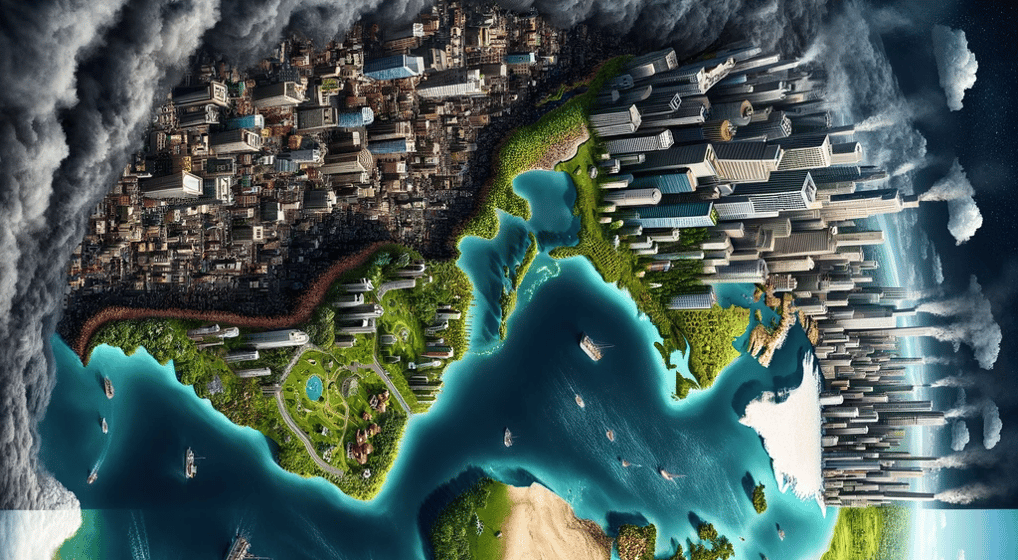The Political Economy of Climate Change: Unraveling the Dynamics
This article examines the interplay between politics, economics, and the environmental repercussions of climate change. It highlights the historical significance of emissions patterns, especially after the Industrial Revolution, and discusses the uneven impact felt by the Global South, emphasizing the urgent need for climate justice.
CLIMATE CHANGE
10/12/20232 min read


Climate change, a global challenge with complex societal implications, has intricately woven links to political, economic, and industrial processes. In our quest to understand and navigate this critical issue, the political economy perspective provides valuable insights, connecting power dynamics, economic incentives, and environmental consequences.
Historical Perspective: CO2 and the Industrial Revolution
From the last ice age to present day, carbon dioxide (CO2) concentrations have dramatically shifted. Pre-industrial times witnessed atmospheric CO2 levels hovering around 200-280 parts per million (ppm) during alternating ice ages and warmer interglacial periods. By 2013, this number had surged beyond 400 ppm for the first time in recorded history[2]. The Industrial Revolution, starting around 1750, marked a pivotal moment in this narrative, introducing large-scale manufacturing, increased fossil fuel consumption, and unprecedented greenhouse gas emissions[3][8].
Global Temperature: Emissions and Their Impacts
The consequence of rising emissions is starkly evident in global temperature trends. A direct link exists between human emissions of greenhouse gases, primarily CO2, and the upsurge in global temperatures[5]. The NOAA's 2021 Annual Climate Report underscores that global temperature rates since 1981 have increased at double the pace compared to the average from 1880[10].
Who Bears the Brunt?
Despite the universal consequences of climate change, responsibility and repercussions are unequally distributed. Historically, the Global North, particularly North American nations, have been the primary contributors to CO2 emissions. However, it's often the Global South, despite their minimal contribution, that faces the harshest impacts of climate-induced challenges.
A stark class gap persists within countries as well. Regions like Africa, with the least emissions, are disproportionately affected by climate change. This disparity calls into question the concept of climate justice: How do we equitably allocate the responsibility of mitigation and adaptation?
The Role of Major Players
While the U.S. has led the Global North in oil production and emissions, China dominates the Global South with coal-based emissions. It's crucial to highlight that commitments made by these major players often diverge from their actual actions. The U.S., for instance, has struggled to meet its climate commitments, whereas countries like China and India have shown a closer alignment between their promises and actions.
Towards a Sustainable Future: Strategies and Solutions
The path forward necessitates actionable strategies:
1. Carbon Trading Framework: Establishing a system where carbon is priced can encourage reductions in emissions.
2. Global Solidarity: Creating an international carbon front and promoting collective efforts, especially within the Global South, can enhance mitigation and adaptation capabilities.
3. Compensation: Countries that exceed their fair share of emissions should compensate those that are below the threshold. This fosters a sense of global responsibility and equity.
Conclusion
The political economy of climate change emphasizes the intertwined nature of politics, economics, and the environment. As we continue our journey towards a sustainable future, understanding these interconnections will be pivotal. From historical CO2 trends to the role of global powers, and from the complexities of carbon trading to the principles of justice and equity, our collective response to climate change will define the future of our planet.
[^2^]: [NASA Climate](https://climate.nasa.gov/climate_resources/24/graphic-the-relentless-rise-of-carbon-dioxide/)
[^3^]: [2041 Foundation](https://2041foundation.org/climate-change-what-happened-and-why/)
[^5^]: [Our World in Data](https://ourworldindata.org/co2-and-greenhouse-gas-emissions)
[^8^]: [Greenly Earth](https://greenly.earth/en-us/blog/ecology-news/what-was-the-industrial-revolutions-environmental-impact)
[^10^]: [NOAA Climate](https://www.climate.gov/news-features/understanding-climate/climate-change-global-temperature)


